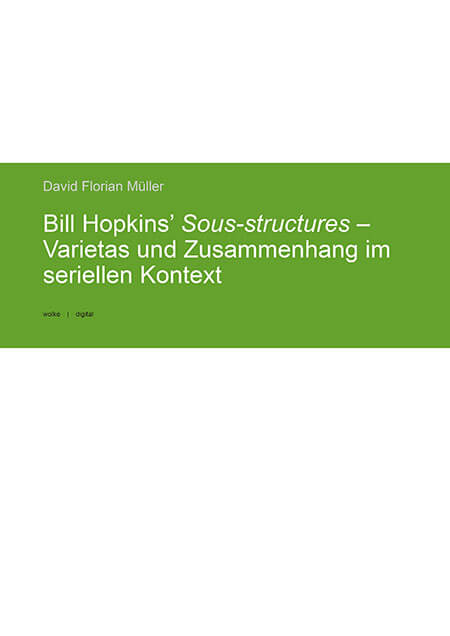
open access
David Florian Müller
Bill Hopkins’ Sous-structures –
Varietas und Zusammenhang im seriellen Kontext
Der Komponist Bill Hopkins ist heute nur Kennern der seriellen Musik ein Begriff. Er folgte in den 60ern auf die erste Generation der Serialisten, die für ihn maßgebliche Einflüsse darstellten (Barraqué, Messiaen, Boulez, Nono).
Vorliegende Arbeit stellt die erste umfassende Analyse eines Werks Hopkins‘ dar und kann somit den Grundstein zur Erschließung und Erforschung seines weiteren Œuvre liefern. Sous-structures (1964) für Klavier in fünf Sätzen stellt hierbei Hopkins‘ erstes gültiges Werk dar. Wie aus einer Skizze zu dem Werk hervorgeht, ist das Werk in Kreisen konzipiert, die sich auf verschiedenen Ebenen (Werk, Satz und Zeile) wiederfinden. Inwiefern diese Kreisstruktur sich kompositorisch erkennen lässt, versucht diese Arbeit durch Analyse zu zeigen. Außerdem wird in der Arbeit dargestellt, dass es nicht ‚das‘ serielle Komponieren gibt und sich serielle Musik durch eine Vielfalt an Techniken auszeichnet, wie durch den formkonstituierenden Wechsel der verschiedener Kompositionstechniken in Sous-structures ausgeführt wird. Dabei wird auf der anderen Seite gezeigt, wie Hopkins es trotzdem schafft zwischen den verschiedenen Ebenen (Werk, Satz, Zeile) Zusammenhänge herzustellen.
Today, the composer Bill Hopkins is only known to connoisseurs of serial music. In the 1960s, he followed the first generation of serialists, who were significant influences on him (Barraqué, Messiaen, Boulez, Nono).
This work represents the first extensive analysis of one of Hopkins‘ works and can thus provide the basis for the exploration and research of his further oeuvre. Sous-structures (1964) for piano, consisting of five movements, is Hopkins‘ first valid work. As can be seen from a sketch of the work, it is conceived in concentric circles that can be found on different levels (work, movement and stave). This analysis attempts to demonstrate the extent to which this circular structure manifests itself compositionally. In addition, the work shows that there is no such thing as ‚the‘ serial composition and that serial music is characterised by a variety of techniques, such as the form-constituting change of different compositional techniques in Sous-structures. On the other hand, it is shown how Hopkins nevertheless manages to establish connections between the different levels (work, movement, stave) in Sous-structures.
117 S.

